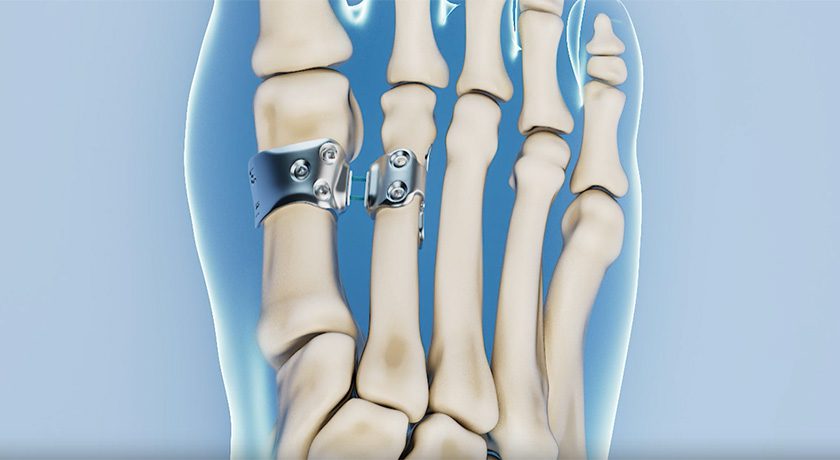

 Copy to clipboard
Copy to clipboard 
We estimate the joint replacement market grew in the mid-single-digits to a worldwide total of $22.6 billion in 2024, making it the largest segment in orthopedics. Joint replacement is also an important vector for enabling technologies entering the market, further solidifying the segment’s importance.
As we move into 2025, we expect normalized procedure volume, increased competition around enabling technology and perhaps a bold M&A move among the segment’s top players. We dive into more detail for each topic below.
You can also check out our brief video covering the State of Joint Replacement in 2025:
Procedure Volumes Have Normalized
Joint replacement procedures enjoyed significant demand and growth over the last few years. According to most companies, volume normalized in late 2024 and early 2025.
Backlogged and deferred procedures drove much of the segment’s upside over the last few years. Most joint replacement players didn’t surpass their 2019 knee and hip sales levels until 2023. By now, however, the market has mostly caught up.
“As we look at procedures within the year to come, we believe that they have, for the most part, normalized,” said J&J Executive Vice President, MedTech Tim Schmid. “We expected some tailwinds from the backlog, specifically in orthopedic procedures. We believe that for the most part around the world, procedures have normalized to pre-COVID levels and we expect the same as we now move into 2025.”
Even with the segment returning to baseline, there’s a growing sentiment among some orthopedic executives that the baseline has moved up. Favorable demographics, growing ASC capacity, improving technology and patient activity levels could accelerate joint replacement’s growth rate.
More Competition in Enabling Technology
The proliferation of enabling technology into joint replacement changed its competitive dynamics and could play an important role in driving future growth.
Stryker’s combination of its Mako robot and cementless implants transformed its knee replacement business. It took a while for its competitors to enter the robotics market, but ultimately they did and started generating their own success stories.
J&J MedTech, for instance, rapidly globalized its VELYS ecosystem across 20 countries and saw significant OUS knee replacement sales growth.
Shoulder robots are shaping up to be the next front in the battle between joint replacement companies. Zimmer Biomet entered the space first with ROSA Shoulder and believes it could change the standard of care. The system can do both anatomic and reverse cases and the company said it is extremely fast and accurate, resulting in shorter surgeries and faster recovery.
Zimmer Biomet has also emerged as an early champion of optionality across its technology portfolio. In addition to its own navigation and robotic systems, the company acquired OrthoGrid for its AI-driven surgical guidance while also partnering with THINK Surgical to distribute its TMINI handheld robot.
Despite its apparent ubiquity, not all surgeons are sold on robotics in joint replacement. Likewise, these systems tend to be prohibitively expensive for many customers and require volume or share-based consignment deals.
Orthopedic enabling technology still has some hurdles to clear before it crosses over into the mainstream. However, the reception of shoulder robotics could give us an indication of where surgeons are on the adoption curve.
Don’t Rule Out a Major M&A Transaction
This one is a bit counter intuitive, and more than a bit speculative, but we can’t rule out a major M&A move within joint replacement. It typically isn’t a very active segment for orthopedic M&A.
Fewer than 12% of transactions over the last decade involved joint replacement in some way. In three of the last four years, there’s been a single M&A transaction involving joint replacement.
But even as orthopedic M&A transaction volume plunges, we’re still seeing very large transactions take place and they’re mostly working! Stryker’s home run acquisition of Wright Medical likely has some competitors kicking themselves over the missed opportunity.
“We’ve gotten really good at evaluations and integrations,” said Stryker CEO Kevin Lobo. “Early in my tenure, we weren’t so good at integrations. If I look at Wright Medical, it’s just been a role model for how to integrate a complex business, and the results have been stellar.”
We’ve even seen Orthofix and Globus Medical pull off complex integrations in spine, an infamously challenging space for M&A integration. While not purely focused on joint replacement, Zimmer Biomet’s acquisition of Paragon 28 shows that companies are willing to pay a premium for the right assets.
These moves, combined with Stryker’s divestment of spinal implants, signals to us that the top players aren’t afraid to make bold strategic moves.
It is fair to say Smith+Nephew’s recon business is probably a distressed asset at this point. Could that be sold off to a competitor or private equity? There are some mid-tier European players that could be transformative for both scale and globalization but also cost a ransom, if they’re even available.
The joint replacement market entered 2025 with momentum, and its growth could be aided by durable and convergent tailwinds. However, players in the space face more competition than ever and will have to make bold strategic moves to win in the coming years.
We estimate the joint replacement market grew in the mid-single-digits to a worldwide total of $22.6 billion in 2024, making it the largest segment in orthopedics. Joint replacement is also an important vector for enabling technologies entering the market, further solidifying the segment's importance.
As we move into 2025, we expect...
We estimate the joint replacement market grew in the mid-single-digits to a worldwide total of $22.6 billion in 2024, making it the largest segment in orthopedics. Joint replacement is also an important vector for enabling technologies entering the market, further solidifying the segment’s importance.
As we move into 2025, we expect normalized procedure volume, increased competition around enabling technology and perhaps a bold M&A move among the segment’s top players. We dive into more detail for each topic below.
You can also check out our brief video covering the State of Joint Replacement in 2025:
Procedure Volumes Have Normalized
Joint replacement procedures enjoyed significant demand and growth over the last few years. According to most companies, volume normalized in late 2024 and early 2025.
Backlogged and deferred procedures drove much of the segment’s upside over the last few years. Most joint replacement players didn’t surpass their 2019 knee and hip sales levels until 2023. By now, however, the market has mostly caught up.
“As we look at procedures within the year to come, we believe that they have, for the most part, normalized,” said J&J Executive Vice President, MedTech Tim Schmid. “We expected some tailwinds from the backlog, specifically in orthopedic procedures. We believe that for the most part around the world, procedures have normalized to pre-COVID levels and we expect the same as we now move into 2025.”
Even with the segment returning to baseline, there’s a growing sentiment among some orthopedic executives that the baseline has moved up. Favorable demographics, growing ASC capacity, improving technology and patient activity levels could accelerate joint replacement’s growth rate.
More Competition in Enabling Technology
The proliferation of enabling technology into joint replacement changed its competitive dynamics and could play an important role in driving future growth.
Stryker’s combination of its Mako robot and cementless implants transformed its knee replacement business. It took a while for its competitors to enter the robotics market, but ultimately they did and started generating their own success stories.
J&J MedTech, for instance, rapidly globalized its VELYS ecosystem across 20 countries and saw significant OUS knee replacement sales growth.
Shoulder robots are shaping up to be the next front in the battle between joint replacement companies. Zimmer Biomet entered the space first with ROSA Shoulder and believes it could change the standard of care. The system can do both anatomic and reverse cases and the company said it is extremely fast and accurate, resulting in shorter surgeries and faster recovery.
Zimmer Biomet has also emerged as an early champion of optionality across its technology portfolio. In addition to its own navigation and robotic systems, the company acquired OrthoGrid for its AI-driven surgical guidance while also partnering with THINK Surgical to distribute its TMINI handheld robot.
Despite its apparent ubiquity, not all surgeons are sold on robotics in joint replacement. Likewise, these systems tend to be prohibitively expensive for many customers and require volume or share-based consignment deals.
Orthopedic enabling technology still has some hurdles to clear before it crosses over into the mainstream. However, the reception of shoulder robotics could give us an indication of where surgeons are on the adoption curve.
Don’t Rule Out a Major M&A Transaction
This one is a bit counter intuitive, and more than a bit speculative, but we can’t rule out a major M&A move within joint replacement. It typically isn’t a very active segment for orthopedic M&A.
Fewer than 12% of transactions over the last decade involved joint replacement in some way. In three of the last four years, there’s been a single M&A transaction involving joint replacement.
But even as orthopedic M&A transaction volume plunges, we’re still seeing very large transactions take place and they’re mostly working! Stryker’s home run acquisition of Wright Medical likely has some competitors kicking themselves over the missed opportunity.
“We’ve gotten really good at evaluations and integrations,” said Stryker CEO Kevin Lobo. “Early in my tenure, we weren’t so good at integrations. If I look at Wright Medical, it’s just been a role model for how to integrate a complex business, and the results have been stellar.”
We’ve even seen Orthofix and Globus Medical pull off complex integrations in spine, an infamously challenging space for M&A integration. While not purely focused on joint replacement, Zimmer Biomet’s acquisition of Paragon 28 shows that companies are willing to pay a premium for the right assets.
These moves, combined with Stryker’s divestment of spinal implants, signals to us that the top players aren’t afraid to make bold strategic moves.
It is fair to say Smith+Nephew’s recon business is probably a distressed asset at this point. Could that be sold off to a competitor or private equity? There are some mid-tier European players that could be transformative for both scale and globalization but also cost a ransom, if they’re even available.
The joint replacement market entered 2025 with momentum, and its growth could be aided by durable and convergent tailwinds. However, players in the space face more competition than ever and will have to make bold strategic moves to win in the coming years.

You are out of free articles for this month
Subscribe as a Guest for $0 and unlock a total of 5 articles per month.
You are out of five articles for this month
Subscribe as an Executive Member for access to unlimited articles, THE ORTHOPAEDIC INDUSTRY ANNUAL REPORT and more.
ME
Mike Evers is a Senior Market Analyst and writer with over 15 years of experience in the medical industry, spanning cardiac rhythm management, ER coding and billing, and orthopedics. He joined ORTHOWORLD in 2018, where he provides market analysis and editorial coverage.







